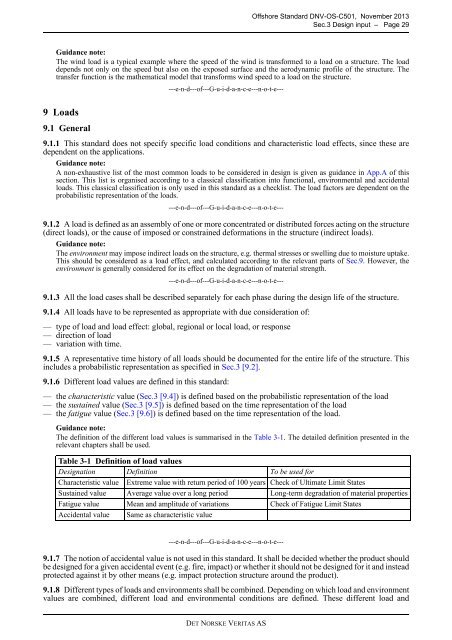OS-C501
You also want an ePaper? Increase the reach of your titles
YUMPU automatically turns print PDFs into web optimized ePapers that Google loves.
Offshore Standard DNV-<strong>OS</strong>-<strong>C501</strong>, November 2013<br />
Sec.3 Design input – Page 29<br />
Guidance note:<br />
The wind load is a typical example where the speed of the wind is transformed to a load on a structure. The load<br />
depends not only on the speed but also on the exposed surface and the aerodynamic profile of the structure. The<br />
transfer function is the mathematical model that transforms wind speed to a load on the structure.<br />
9 Loads<br />
9.1 General<br />
---e-n-d---of---G-u-i-d-a-n-c-e---n-o-t-e---<br />
9.1.1 This standard does not specify specific load conditions and characteristic load effects, since these are<br />
dependent on the applications.<br />
Guidance note:<br />
A non-exhaustive list of the most common loads to be considered in design is given as guidance in App.A of this<br />
section. This list is organised according to a classical classification into functional, environmental and accidental<br />
loads. This classical classification is only used in this standard as a checklist. The load factors are dependent on the<br />
probabilistic representation of the loads.<br />
---e-n-d---of---G-u-i-d-a-n-c-e---n-o-t-e---<br />
9.1.2 A load is defined as an assembly of one or more concentrated or distributed forces acting on the structure<br />
(direct loads), or the cause of imposed or constrained deformations in the structure (indirect loads).<br />
Guidance note:<br />
The environment may impose indirect loads on the structure, e.g. thermal stresses or swelling due to moisture uptake.<br />
This should be considered as a load effect, and calculated according to the relevant parts of Sec.9. However, the<br />
environment is generally considered for its effect on the degradation of material strength.<br />
---e-n-d---of---G-u-i-d-a-n-c-e---n-o-t-e---<br />
9.1.3 All the load cases shall be described separately for each phase during the design life of the structure.<br />
9.1.4 All loads have to be represented as appropriate with due consideration of:<br />
— type of load and load effect: global, regional or local load, or response<br />
— direction of load<br />
— variation with time.<br />
9.1.5 A representative time history of all loads should be documented for the entire life of the structure. This<br />
includes a probabilistic representation as specified in Sec.3 [9.2].<br />
9.1.6 Different load values are defined in this standard:<br />
— the characteristic value (Sec.3 [9.4]) is defined based on the probabilistic representation of the load<br />
— the sustained value (Sec.3 [9.5]) is defined based on the time representation of the load<br />
— the fatigue value (Sec.3 [9.6]) is defined based on the time representation of the load.<br />
Guidance note:<br />
The definition of the different load values is summarised in the Table 3-1. The detailed definition presented in the<br />
relevant chapters shall be used.<br />
Table 3-1 Definition of load values<br />
Designation Definition To be used for<br />
Characteristic value Extreme value with return period of 100 years Check of Ultimate Limit States<br />
Sustained value Average value over a long period Long-term degradation of material properties<br />
Fatigue value Mean and amplitude of variations Check of Fatigue Limit States<br />
Accidental value Same as characteristic value<br />
---e-n-d---of---G-u-i-d-a-n-c-e---n-o-t-e---<br />
9.1.7 The notion of accidental value is not used in this standard. It shall be decided whether the product should<br />
be designed for a given accidental event (e.g. fire, impact) or whether it should not be designed for it and instead<br />
protected against it by other means (e.g. impact protection structure around the product).<br />
9.1.8 Different types of loads and environments shall be combined. Depending on which load and environment<br />
values are combined, different load and environmental conditions are defined. These different load and<br />
DET NORSKE VERITAS AS



